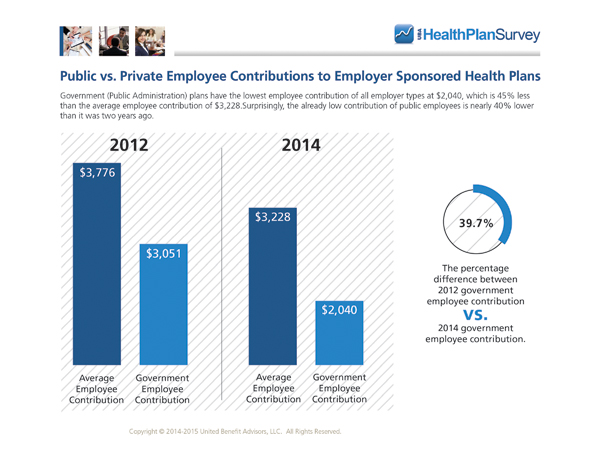19 Jan United Benefit Advisors Reveals 2014 Industry Trends Among Employer Sponsored Health Plans
Originally posted January 13th, 2015 by Bill Olson on www.ubabenefits.com.
Survey finds public employees still most costly to insure yet contribute 45% less than the average employee and nearly 40% less than two years ago
Survey finds public employees still most costly to insure yet contribute 45% less than the average employee and nearly 40% less than two years ago
Indianapolis, IN – [January 12, 2015] – New survey data from the 2014 United Benefit Advisors Health Plan Survey, the nation’s largest health plan survey of nearly 10,000 employers, reveals differences among employer sponsored health plans across various industries, looking specifically at employer cost versus employee contribution.
UBA, the nation’s leading independent employee benefits advisory organization, finds that the average total cost per employee in 2014 was $9,504, of which the average employer cost was $6,276 and average employee contribution, $3,228.
Government (Public Administration) health insurance plans have the highest average cost per employee at $11,329 (17.5% higher than average), with the lowest employee contribution of $2,040, which is 45% less than the average employee. Surprisingly, this already low contribution is an astounding 39.7% lower than two years ago when public employees contributed $3,051.
“The government sector historically has provided generous employee benefits,” says Les McPhearson, CEO of UBA. “The risk that taxpayers face is the forthcoming ‘Cadillac Tax’ if public employers can’t get their health care costs under the $10,200 premium threshold. The Cadillac Tax is hefty – a non-deductible 40% excise tax on the excess benefit – which would increase the average cost per employee.”

Employer cost per employee for the manufacturing, health care, construction, retail, and hospitality services sectors are all 4% to 8% lower than the overall industry average costs, making employees in these industries the least expensive to cover. Employees in the construction industry are one of the least expensive for employers to cover at $5,373 per employee, but contribute the most toward their health benefits paying $3,620, approximately 11% higher than the average.
“The construction industry tends to be made up of young, single males who value higher hourly wages over health benefits,” says Josh Budke, employee benefits advisor with TrueNorth Companies, LLC, a UBA Partner Firm. “Even ‘free’ benefits with no copays, like wellness exams and physicals, don’t get utilized in this industry as much as in others, which leads to a lower cost and higher benefit contribution.”
“In the past, a significant percentage of the employees in the construction and food services industries, many of whom are young, did not value a health plan as part of their compensation package,” says Scott Niederbrach, Principal, Cherry Creek Benefits, a UBA Partner Firm. “Employers responded by not including them and building a business in a relatively small margin industry without the health plan in the business formula. Now that PPACA [the Patient Protection and Affordable Care Act] requires the offering of a health plan to avoid the shared responsibility penalty, the employer is crafting a health plan offering that pegs the price of the plan close to the threshold of the definition of affordability under the regulations. The young demographic of these employees would be expected to lead to a lower health plan cost.”
For further details about industry trends among employer sponsored health plans, download a copy of the 2014 UBA Health Plan Survey Executive Summary at https://bit.ly/1DUpFQ1 or contact ClearPath Benefit Advisors for a customized survey report. For more information about industry trends, click here.






